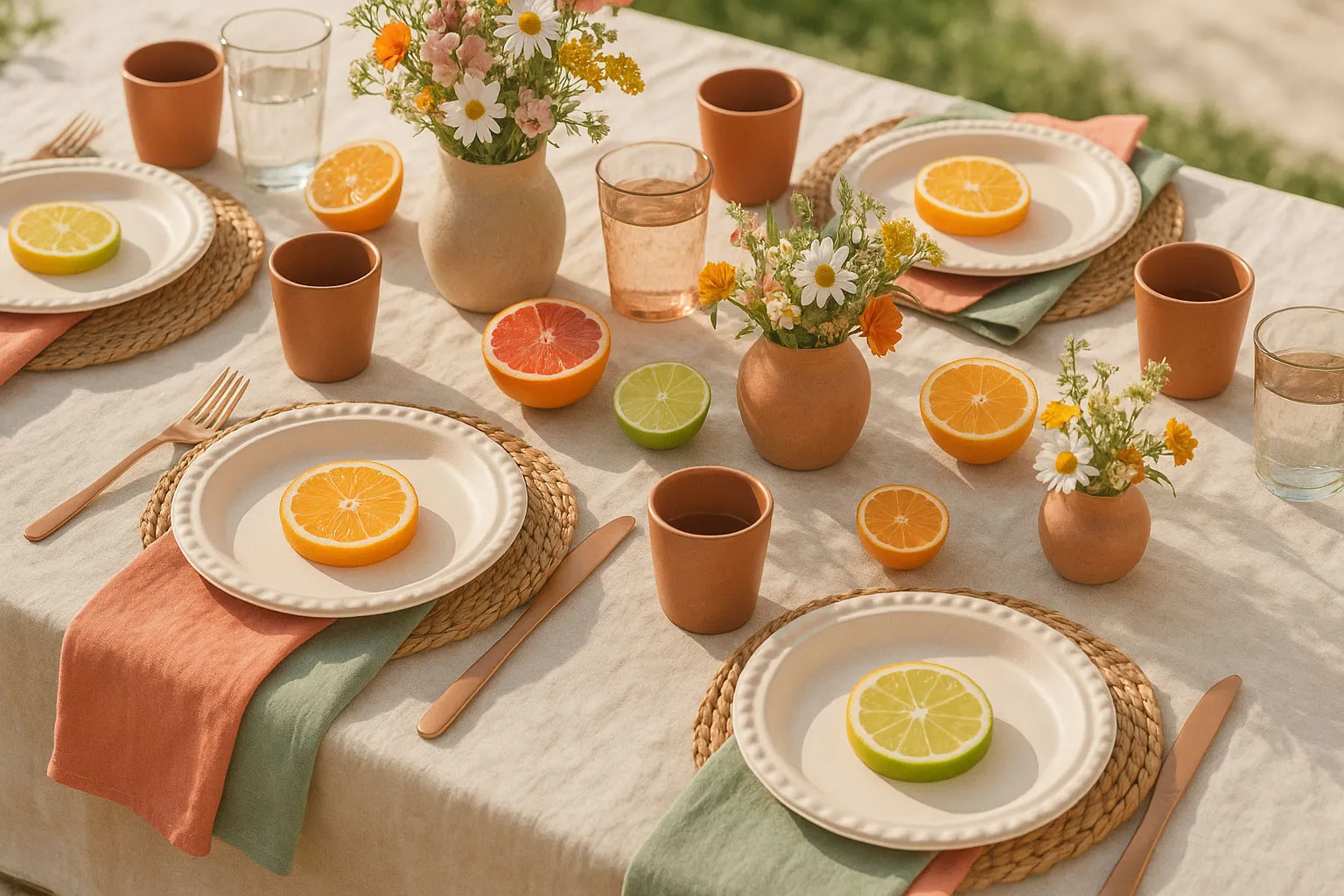By understanding the nuances of compostable plate materials, certifications, performance attributes, and disposal methods, you can confidently select sustainable party supplies that deliver on both function and eco-conscious values. The sections that follow explore these topics in greater depth, offering detailed insights and practical advice to help you choose the perfect compostable plates for any occasion.
Selecting the best compostable plates involves more than simply opting for products labeled “eco-friendly.” It requires a comprehensive understanding of the materials used, their performance characteristics under varied conditions, authentic certifications verifying compostability, and how they will be disposed of after use. Compostable plates are available in a range of materials—including bagasse (sugarcane fiber), molded fiber, palm leaf, and PLA-lined paper—each offering different levels of durability, aesthetics, and environmental impact. Aligning these factors with your event’s food types, guest experience expectations, and waste management infrastructure ensures a responsible choice that balances sustainability with practical convenience.
This article unpacks key considerations for selecting compostable plates, addressing material evaluation, certification verification, and disposal logistics. Whether you’re hosting an intimate backyard gathering or overseeing a large-scale catered event, this guide provides the knowledge to make informed, green choices that do not compromise quality or ease of use.

Understanding Compostable Plates: Materials and Their Eco Impact
The foundation of selecting the best compostable plates lies in understanding the diverse materials that define their environmental benefits and functional suitability. The most common compostable plate materials—bagasse, molded fiber, palm leaf, and PLA-lined paper—each possess unique strengths suited to various event needs and food types.
Bagasse plates, derived from sugarcane fiber, are celebrated for their robustness and natural resistance to moisture and grease, making them an excellent choice for hot and oily foods. Their durability helps prevent leaks and sogginess, which is particularly beneficial in casual events like barbecues or catered meals involving saucy dishes. Conversely, molded fiber plates, typically made from recycled paper or cardboard, are lightweight and generally more suitable for lighter fare. While cost-effective, their durability can be variable, particularly with prolonged use or exposure to oily foods.
For hosts seeking an environmentally conscious yet polished aesthetic, palm leaf plates provide a stylish, rustic appearance coupled with strong heat resistance and compostability. These plates are increasingly popular for upscale events such as weddings or formal dinners, merging sustainability with elegant design. Meanwhile, PLA-lined paper plates are coated with polylactic acid to resist grease and moisture but require commercial composting environments to break down effectively, which limits their use in backyard compost setups.
A crucial but often overlooked aspect is aligning plate materials with both the type of food served and your available disposal infrastructure. Bagasse and palm leaf plates are generally compatible with backyard composting, making them ideal for private gatherings. In contrast, PLA-lined products depend on industrial composting facilities to avoid contributing to landfill waste. Due diligence in verifying material sources and certifications helps avoid misleading claims and ensures genuine compostability.
By deeply understanding material characteristics alongside practical use and end-of-life disposal considerations, hosts and event planners can confidently select compostable plates that fulfill both sustainability objectives and functional event requirements.
Performance Factors: Heat, Grease Resistance, and Durability
While environmental sustainability is paramount, the practical performance of compostable plates is equally critical for guest satisfaction and successful event execution. Key performance attributes include heat tolerance, grease resistance, and physical durability—all of which influence usability and waste outcomes.
Bagasse plates are known for their exceptional heat tolerance and can generally be microwaved without warping or losing integrity, making them highly practical for hot meal service. On the other hand, palm leaf plates, though durable and heat resistant, are typically not recommended for microwave use, a consideration particularly relevant to buffet setups or multi-course events. Plates lined with PLA tend to soften under heat and are usually unsuitable for microwaving unless specifically tested for such conditions. Molded fiber plates vary widely depending on the specific manufacturing process, so it is essential to verify microwave compatibility with suppliers before use.
Grease resistance plays a pivotal role in ensuring plates maintain form and containment throughout a meal service. Both bagasse and PLA-lined plates generally outperform uncoated fiber plates in this regard, preventing oil absorption that can lead to sogginess or structural failure. Plates that become soggy or crack not only disrupt the dining experience but also increase waste through premature disposal or food spills.
Lastly, the structural strength of the plate must align with the nature of the menu and serving style. Thicker bagasse and palm leaf plates provide reliable rigidity, making them ideal for heavier dishes or buffet lines, whereas flimsy or brittle alternatives risk breakage, which can contaminate compost streams and create waste management complications.
Selecting compostable plates with proven heat resilience, grease protection, and physical durability enhances event success while reinforcing your commitment to environmentally sustainable, eco-friendly party supplies.
Verifying Compostability: Certifications and Standards
To ensure that compostable plates live up to their environmental promises, rigorous verification through recognized certifications is essential. This protects against "greenwashing," where products are marketed as eco-friendly without meeting stringent compostability criteria.
The most trusted indicator is the BPI Certified Compostable logo, awarded by the Biodegradable Products Institute. This certification confirms that products comply with ASTM standards and have undergone independent testing to biodegrade fully within commercial composting timeframes without producing toxic residues.
Specifically, standards such as ASTM D6400 and ASTM D6868 outline criteria for compostability, including material composition, biodegradation rate, and environmental safety. Products that meet these standards demonstrate proven performance in industrial composting facilities.
Be cautious of vague marketing terms such as “biodegradable,” “plant-based,” or “eco-friendly” when unsupported by formal certification. Always inspect packaging for clear certification marks, and cross-reference them with BPI registries or ASTM certification databases when purchasing, especially in bulk. Requesting certificates of compliance or material safety data sheets from suppliers further ensures the legitimacy of eco-friendly claims.
Conducting this due diligence guarantees that your compostable plate purchases effectively contribute to sustainable waste diversion, uphold credibility with your guests and stakeholders, and keep your event’s environmental footprint to a minimum.
Composting Logistics: Disposal Options and Local Regulations

Understanding disposal logistics is as critical as selecting the right compostable plate materials. The environmental benefits of using compostable plates depend heavily on the availability and acceptance policies of your local composting infrastructure, as well as clear waste sorting practices to prevent contamination.
In many cases, backyard composting is suitable for fiber-based plates such as uncoated bagasse and palm leaf, which break down effectively over several weeks to months under appropriate conditions. This makes them especially attractive for small-scale events or private gatherings where industrial options are unavailable.
Conversely, compostable plates with PLA lining generally require commercial composting facilities equipped for high-temperature processing to decompose fully. Attempting to compost PLA-lined plates at home can lead to incomplete degradation, creating residual waste and potentially contaminating compost streams.
Municipal composting programs vary widely in their acceptance of compostable products, making it imperative to verify local policies before purchasing specific plate types. Improper disposal not only undermines recycling efficiency but also risks having compost loads rejected or sent to landfills.
To optimize composting success, implement practical measures such as clear waste bin labeling, educating event attendees on proper disposal methods, and, for larger events, partnering with commercial composters for waste handling. This integrated strategy aligns your product choice with practical end-of-life solutions, strengthening the sustainability of your entire event lifecycle.
How to Choose the Best Compostable Plates for Any Occasion
Bringing together knowledge of materials, performance qualities, certifications, and disposal logistics creates a framework for selecting the most suitable compostable plates for any occasion.
For casual gatherings and outdoor picnics, affordable yet robust bagasse or molded fiber plates provide desirable heat and grease resistance, perfectly complementing grilled foods and relaxed settings. Their compatibility with backyard composting simplifies post-event waste management.
In formal events such as weddings, palm leaf plates combine natural elegance with sustainability, enhancing event ambiance with their attractive texture and reliable heat tolerance. These premium options fit upscale themes without compromising compostability.
When orchestrating large parties or professional catering, PLA-lined paper plates may offer benefits such as lower upfront cost and efficient storage. However, these options require confirmed access to industrial composting facilities to ensure proper disposal. Prioritize acquiring BPI-certified products and perform performance testing against your expected menu to avoid issues like sogginess or plate failure during service.
Budget considerations must factor into these choices, with fiber plates often striking a balance between cost and functionality, palm leaf plates commanding a premium for style and durability, and PLA-lined plates varying widely based on certification and supplier reliability.
Smart bulk purchasing involves verifying certification authenticity, trialing plates with your menu, and incorporating disposal logistics into overall budgeting. This comprehensive approach supports your event's success while upholding environmental responsibility at scale.
Practical Real-World Examples and Use Cases
Consider John’s backyard barbecue, where the use of bagasse plates proved effective for serving greasy, hearty burgers and sides. These plates maintained structural integrity throughout the event and composted efficiently in his home compost bin, achieving a significant reduction in landfill waste. This illustrates how matching plate materials to casual food types and accessible composting setups fosters seamless green solutions.
At a bustling corporate event, a catering company paired PLA-lined paper plates with a commercial composting partner. Despite serving a high volume of oily dishes, this coordinated approach ensured zero landfill diversion, highlighting the importance of synchronizing plate performance with proper disposal infrastructure for sustainability at scale.
An eco-conscious wedding planner selected palm leaf plates that enhanced the rustic, natural decor while reliably supporting diverse food presentations. The elegant appearance coupled with compostability created a memorable guest experience and simplified post-event waste sorting.
These examples emphasize the vital intersection of material choice, food type, event scale, and local composting capabilities. They reinforce the expert recommendation to “choose for use, dispose right” to maximize both sustainability and functional success with compostable plates and eco-friendly party supplies.
Conclusion
Selecting the best compostable plates demands a thoughtful integration of material knowledge, performance expectations, authentic certifications, and an understanding of disposal logistics. Recognizing the unique attributes of bagasse, molded fiber, palm leaf, and PLA-lined options equips hosts and event planners to choose plates thoughtfully tailored to their menu, venue, and environmental objectives.
Confirming certifications like BPI and ASTM standards protects against misleading claims, ensuring your purchase supports genuine compostable waste streams. Equally crucial is aligning plate choice with local composting infrastructure—whether home-based or commercial—to maximize environmental benefits and reduce landfill waste.
By applying this holistic approach and learning from practical event examples, you can confidently select compostable plates that combine durability, heat and grease resistance, and attractive design—all while maintaining a strong commitment to sustainability and responsible waste management. This strategic selection process not only enhances event quality and guest satisfaction but also contributes meaningfully to advancing a greener, more sustainable future for the events industry and beyond.
Looking ahead, as compostable technologies evolve and municipal composting infrastructure expands, the opportunity for hosts to minimize their environmental footprint will grow exponentially. Embracing these advancements with proactive education, thoughtful sourcing, and integrated waste strategies will be critical for staying ahead in the movement toward truly sustainable event experiences. The challenge for every event organizer is clear: how will you leverage these tools to lead in eco-friendly hospitality—today and into the future?



